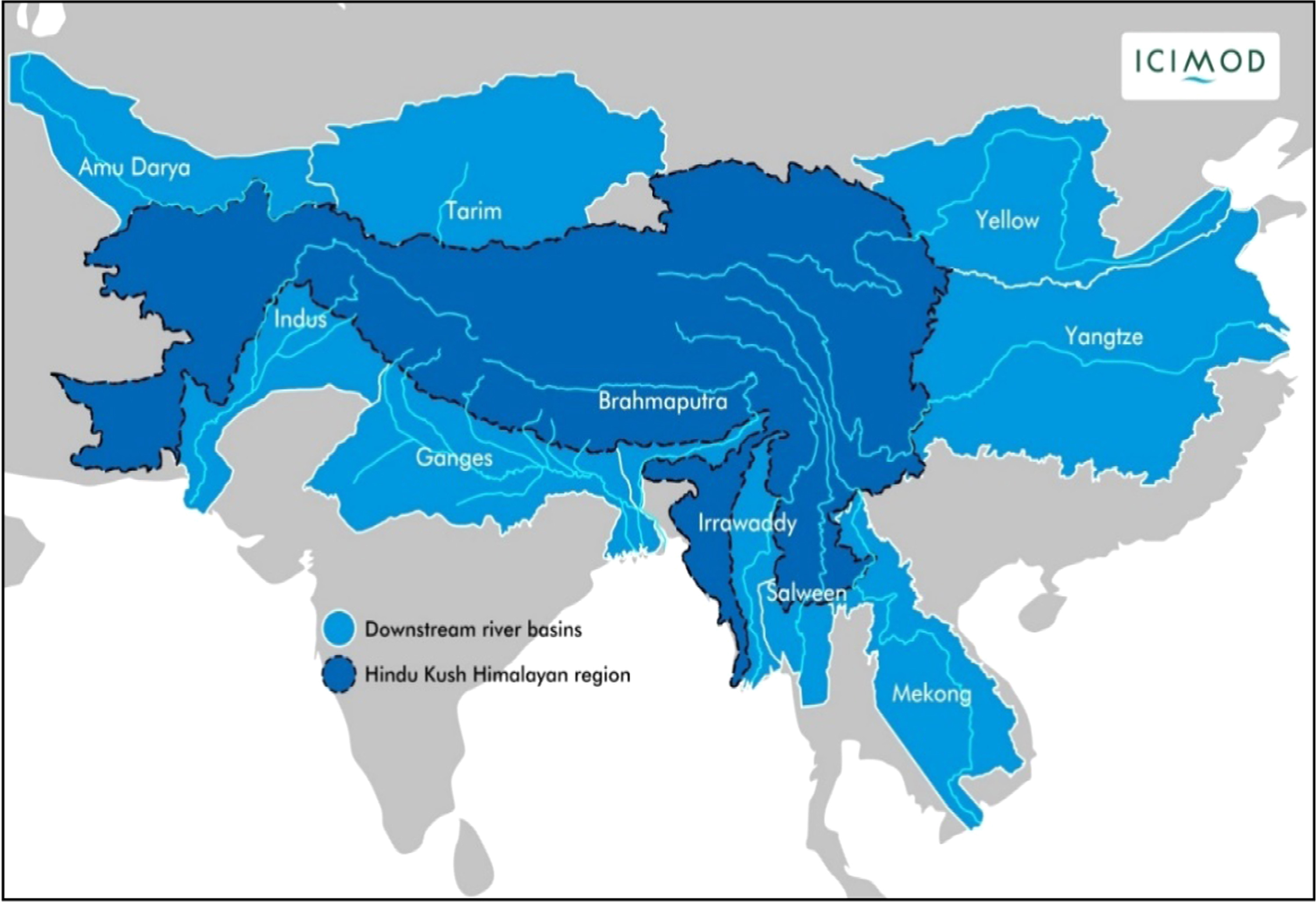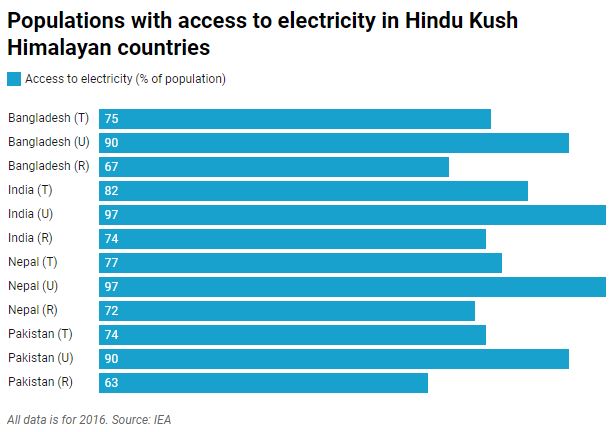Worldwide, the demand for energy has risen significantly and quickly, leading to serious impacts on environmental sustainability and hindering global efforts to mitigate climate change. Hydropower, a leading renewable option has the additional benefits of water storage for agriculture and other uses. Drawing on the position of four Hindu Kush Himalayan (HKH) countries – Bangladesh, India, Nepal and Pakistan – a paper ‘Hydropower development in the Hindu Kush Himalayan region: Issues, policies and opportunities’ investigates the current status of hydropower generation and related policies. Based on this, it attempts to identify the key challenges to and opportunities for hydropower development in the region. The study is based on reliable official documents and published studies on hydropower development in the selected countries.
Hydropower potential in Hindu Kush Himalayan region
South Asia's considerable hydropower potential is concentrated in the HKH region, characterised by high mountains, glaciers and large rivers. The region is the source of ten large river basins that provide water, ecosystem services and livelihoods to a quarter of the world's population.
The four HKH countries mentioned in this study have a hydroelectric potential of 334 Gigawatts. However, owing to inadequate infrastructure, technological constraints and lack of credible cooperation among the countries, only one-third of this potential has actually been tapped so far. Nepal and Pakistan have tapped 2% and 12%, respectively, of their hydropower potential. The current hydropower supply has not been able to fulfil the electricity demand in the region, where 26–37% of the rural population is living without access to electricity, and future demand for electricity is likely to increase sharply.
General perceptions of the environmental impacts of hydropower projects also result in low local acceptability of these projects. Another study conducted in Jammu and Kashmir revealed that local communities perceived hydropower projects as a source of noise pollution, waterlogging and soil erosion, deteriorating water quality, as well as leading to losses in animal, bird and plant diversity.

In the paper on hydropower development and potential in the HKH region, a detailed situation analysis is provided, guided by the following specific objectives:
- Assessing the state of energy resources and access to energy by each country’s respective population;
- Taking stock of the hydropower resource potential and identifying the gap between the commercially feasible potential and the installed capacity;
- Identifying and critically examining key known issues related to hydropower development;
- Carrying out a critical assessment of legal provisions/policies governing renewable energy in general and hydropower in particular, and
- Identifying key opportunities for hydropower development in the region and suggesting the possible way forward and scope for regional cooperation.
The situation analysis mainly relied on an extensive review of existing literature (published journal articles, reports, and policy documents), and descriptive statistical analysis (e.g. percentages and trend analysis).

Economic, social, technical, institutional and political issues
Evidence from the HKH region shows that local communities living in areas adjoining hydropower projects are the most vulnerable to the impacts of these projects. There are many issues with land acquisition for hydropower project development - local people are displaced, communities are disturbed and livelihoods are disrupted.
As mentioned earlier as well, all these lead to strong resistance to such projects, further hindering hydropower development in the region. In some cases (for instance in Himachal Pradesh, India), common pool resources such as forests and pastures are also affected, directly impacting the livelihoods of local communities. Generating alternative livelihoods has been challenging because of the limited skill sets of locally displaced youth.
In Himachal Pradesh and in Jammu and Kashmir, the local people also raised issues about cracks in their houses and shops due to the blasting activities carried out to cut rocks near the inhabited areas. The incidence of waterborne diseases such as malaria also increased in adjoining areas, as reported by Bose et al.
Environmental, ecological, physical and geological issues
Overall, hydropower is a cleaner option for energy than non-renewable energy resources such as coal or gas. However, in project areas and some adjacent locations, hydropower developments may have some environmental, ecological and geological impacts. The HKH region is very rich in globally significant biodiversity, and large hydropower development projects may disturb or destroy the habitats of several terrestrial plant and animal species. Studies in the HKH found that deforestation can occur, leading not only to diversity loss in forest ecosystems, but also affecting the communities depending on forests for their livelihoods.
Limited exploitation of hydropower potential is also partly due to problems associated with the geological features of the region. The HKH region is in a seismic zone, so it is imperative to take earthquake resilience into account during construction, to avoid adverse future impacts on populations.
Current policies and strategies on hydropower
The four countries considered in this study have various policies and strategies on energy, and have started to pay attention to renewable energy resources, including hydropower. Apart from a national policy, state-level policies (e.g. in Uttarakhand and Sikkim) are also in place to promote hydropower development.
A review of central-level policies in India reveals some interesting facets of its hydro-energy policy focus. Policies that evolved in the domain of energy, such as the Electricity Act 2003, National Electricity Policy 2005, Tariff Policy 2006, Rural Electrification Policy 2006 and Hydro Power Policy 2008 all provide for the development of renewable energy in general, with specific provisions to promote the hydro-energy sector.
Conclusions
Energy-related policies and strategies of HKH countries have emphasized renewable energy resources, and particularly hydropower production. In this enabling policy environment, the study urges these four countries to realize the untapped potential of hydropower production, not only to fulfil the growing demand for electricity, but also to meet SDG-7 on clean and affordable energy.
To achieve this goal, the authors suggest that the following opportunities should be capitalized on:
Large, ‘smart’ hydropower projects may be developed, taking into account the economic, environmental and social concerns of local and downstream communities, in addition to national economic benefits. Technical provisions in smart projects can minimize the impacts on aquatic life and terrestrial ecosystems.
Microhydel project may also be promoted, as these have less of an adverse social and environmental impact on local communities. Several studies have found that microhydel projects are a very suitable and successful technological and developmental intervention in the HKH regions of Pakistan, Nepal and India.
Electricity shortages and growing demand in the region itself, open up the possibility for regional electricity trade. Countries with potential for hydropower generation could benefit greatly by connecting their hydropower stations to transboundary power grids and trading electricity with other nations. Trade in the energy sector can help countries to strengthen their national energy security, move smoothly to renewable energy regimes, optimize the cost of electricity and minimize adverse impacts from energy price volatility. It might also positively impact industrial production, Gross Domestic Product (GDP), foreign exchange gains and progress in rural electrification in the participating countries.
Recognizing the importance of electricity in promoting economic growth in the region, there is a need to operationalize the bilateral and regional cooperation agreements on energy security that exist between these countries. This involves establishing cross-border infrastructure and promoting regional forums for sharing knowledge and experience widely available within the region. In this regard, the formal process of energy cooperation at the SAARC level may be followed, to address policy, legal and regulatory issues, and to support energy development programs through large-scale infrastructure investment and technical assistance. Moreover, regional platforms such as the International Center for Integrated Mountain Development may also be used for sharing knowledge and experiences.
The paper can be viewed here













